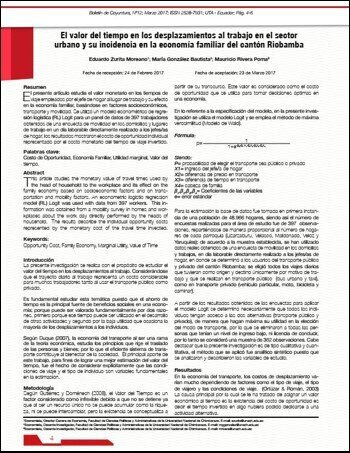The value of time in travel to work in the urban sector and its impact on the family economy of the Riobamba canton
Main Article Content
Abstract
This article studies the monetary value of travel times used by the head of household to the workplace and its effect on the family economy based on socioeconomic factors and on transportation and mobility factors. An econometric logistic regression model (RL) Logit was used with data from 397 workers. This information was obtained from a mobility survey in homes and workplaces about the work day directly performed by the heads of household. The results describe the individual opportunity costs represented by the monetary cost of the travel time invested.
DOI: https://doi.org/10.31164/bcoyu.12.2017.622
URL: http://revistas.uta.edu.ec/erevista/index.php/bcoyu/article/view/622
Downloads
Article Details

This work is licensed under a Creative Commons Attribution-NonCommercial 4.0 International License.
References
Dirección de Tránsito, Movilidad y Transporte de Riobamba. (2014).
Duque, G. (2007). “INTRODUCCIÓN A LA ECONOMÍA DEL TRANSPORTE”. Manizales-Colombia.
Duque, H. (2007). Como mejorar las relaciones Familiares (Vol. 7ª). Bogotá, Colombia: San Pablo.
Gutiérrez, D. (2008). ¿Cuánto cuesta ir al trabajo? El coste en tiempo y en dinero. Barcelona, España: La Caixa.
Gutiérrez, M. (2008). ¿Cuánto cuesta ir al trabajo? Barcelona: Caixa.
Gutiérrez, M., & Doménech. (2008). Cuánto cuesta ir al trabajo - El conto en Tiempo y Dinero. Documentos de Economía “La Caixa””.
Independientes, F. d. (2012). Economía Doméstica, El presupuesto. 32.
Instituto Nacional de Estadística y Censos. (2010). Censo de Población y Vivienda.
Instituto Nacional de Estadística y Censos. (2012). Encuesta de ingreso y gastos. Quito.
Instituto Nacional de Estadística y Censos. (2014). Encuesta Nacional de Empleo, Desempleo y Subempleo (ENEMDU).
Ortúzar, J., & Román, C. (2003). El problema de modelación de demanda desde una. http://www.scielo.cl/scielo.php?script=sci_arttext&pi-d=S0250-71612003008800007.
SIISE. (s.f.). Sistema Integrado de Indicadores Sociales del Ecuador.
Sistema Integrado de Indicadores Sociales del Ecuador. (2010).


